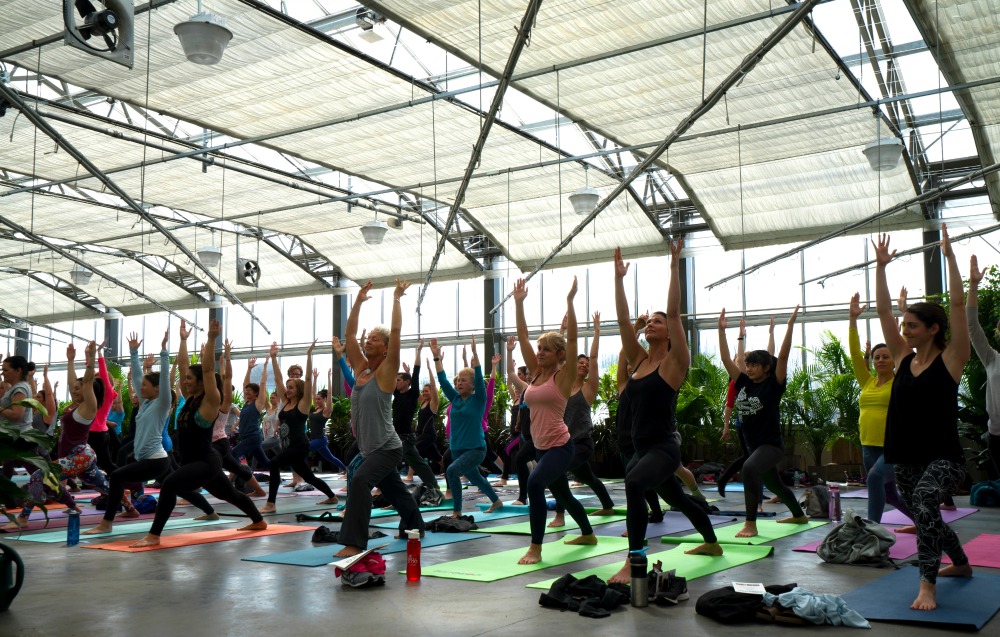To say that yoga has grown rapidly in recent years would be an understatement. From yoga studios and classes, to yoga pants and retreats, this activity and its associated trends can be found everywhere. But don’t be fooled, yoga is more than just the latest fad, it has some incredible health benefits for both the body and mind.
You’ve heard the buzz about yoga – perhaps you’ve even given it a try – but do you know why yoga is good for you?
Check out these five health benefits:
Boost your immune system
When your body moves from one post to another, your muscles contract and stretch and your organs shift. As a result, lymph, a fluid with white blood cells, is released. Lymph is an essential component of your body’s immune system as it helps fight infection and cancerous cells, disposes of toxins, and boosts your body’s immunity.
Additionally, yoga can reduce stress, which causes the cortisol levels found in your adrenal glands to rise. If they don’t reduce appropriately, your immune system becomes compromised, and if constantly heightened, can lead to subpar memory, depression, insulin resistance, high blood pressure, and osteoporosis. Yoga reduces stress and keeps your immune system in check.
Release tension in your limbs
Chronic tension is common in the form of headaches, but it can also be the reason for sore wrists, arms, shoulders, neck, and face. The tension in these areas can make you feel stressed, uncomfortable, and moody. As you practice yoga, you begin to tune into your body’s needs and understand where you hold tension. Once you become more aware, you are able to make a conscious effort to relax those areas, and as a result, feel lighter, less fatigued, and much more comfortable doing daily activities.
Relieve stress and digestive problems
Stress negatively affects so many areas of our body, including our digestive system. Ulcers, irritable bowel syndrome, and constipation can all be worsened by stress. Therefore, the substantial stress-reducing properties of yoga improve the functionality of your digestive system. Additionally, yoga, like any physical exercise, can ease constipation, because the movement drives food through your digestive system faster.
Improve lung function
An essential component of yoga is its unique breathing technique. It involves taking fewer breaths, each with a greater volume of air, through the nose rather than the mouth. Breathing through the nose filters the air, warms it, and humidifies it – making it cleaner for your lungs and less sensitive to people with asthma. This increases the amount of oxygen in your blood, allowing for a higher level of physical exertion; not to mention, its calming effects.
Experience deeper sleep
The fast-paced chaos of everyday life can be strenuous on the nervous system. Due to its roots in meditation, yoga is about relaxation, focusing on the present, the slowing of your breath, and a shift from your fight-or-flight response system to a restorative, self-assessment nervous system. Yoga teaches participants to turn the senses inward – to assess your body rather than the world in which it exists. This reduces stress, relaxes the body and the mind, making it easier to fall asleep and wake feeling rejuvenated and energized.
Now it’s time to give it a try.
Here are six beginner poses you can try at home.
Mountain Pose
Mountain pose is the basis for all standing yoga poses. It involves standing with your feet flat on the ground, hip-width apart, and slowly reaching your arms towards the ceiling while inhaling. After holding your arms outstretched for a few breaths, exhale bringing them down to your sides. This pose provides balance and support while allowing you to focus on your breathing.
Child’s Pose
Child’s pose is a calming pose that stretches the back and encourages digestion. For this pose, you start on your knees, slowly lower your hips to your feet and your head to the mat. Stretch your arms out in front of your head and focus on your breathing for up to 12 breaths.
Cat/Cow Pose
This pose is great for improving mobility and working your core. Cat/Cow pose begins on your hands and knees. On the exhale, round your back toward the ceiling and tuck in your chin while loosening your neck. On the inhale, arch your back and lift your head and tailbone upwards.
Downward Facing Dog
Downward facing dog is the ultimate stretching pose for beginners because it’s calming and helps you remain centered. From your hands and knees, extend your feet back, placing them approximately hips-width apart, then place your palms on the mat past your shoulders, fingers wide. Press your body back into a V-position, lifting through your tailbone.
Warrior I
Warrior I strengthens your legs and opens your hips and chest, all while stretching your arms and legs. Make balance your first goal for this pose. Begin in mountain pose. Then, with slow breaths, step one foot back into a lunge position, raise your arms up. Be sure that your bent knee is directly over your ankle. Drop your chest and shoulders back, and keep your hips square.
Corpse Pose
Corpse pose is an excellent way to end a yoga session because it offers complete relaxation and turns your senses inward to recognize your body’s needs. Lie on your back, arms loosely to your sides with palms facing up and feet relaxed so that they fall to their sides. Relax your entire body, including your face, forehead, and eyes.
To learn more about these beginner poses or the basics of yoga, click here!

